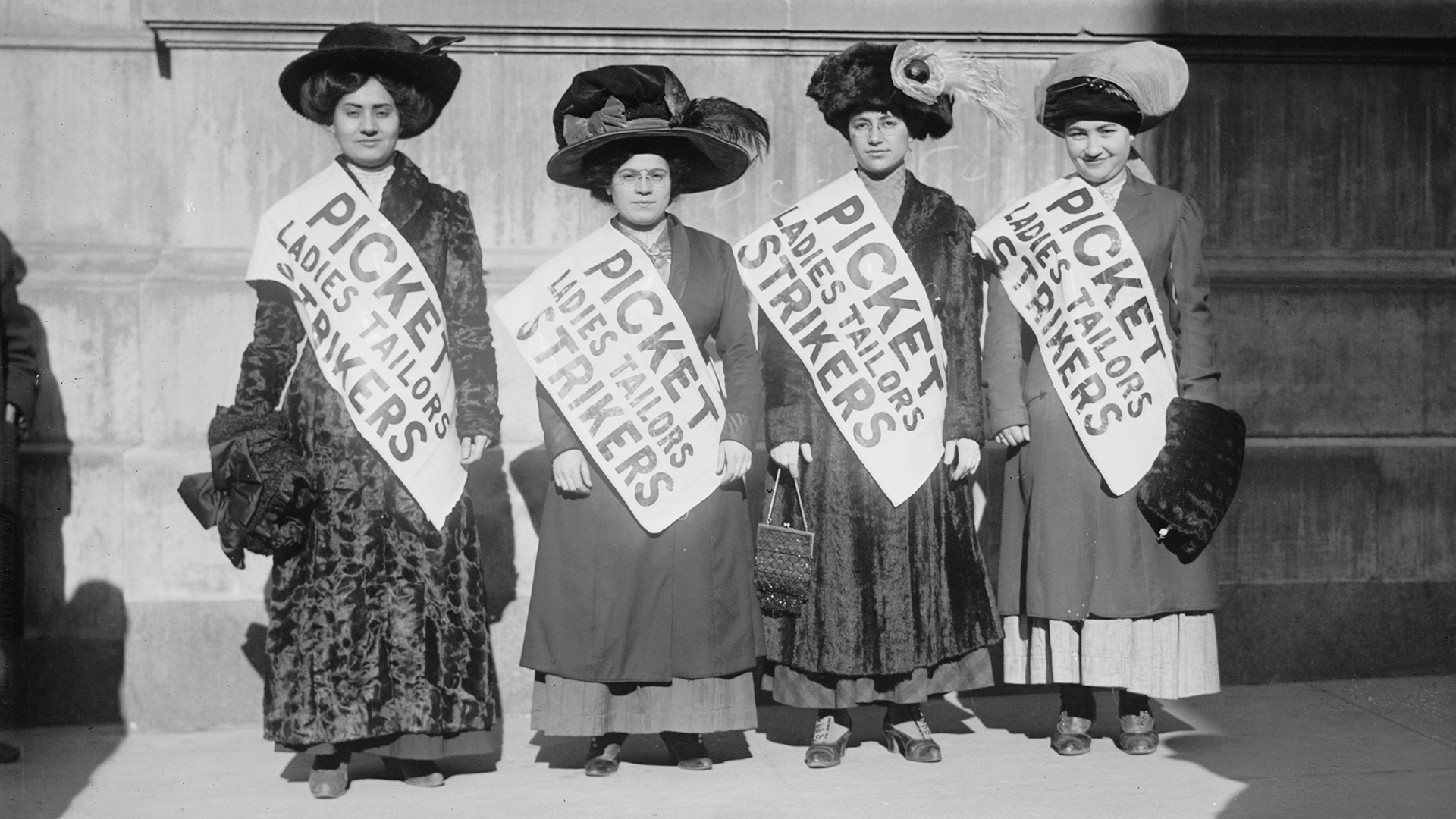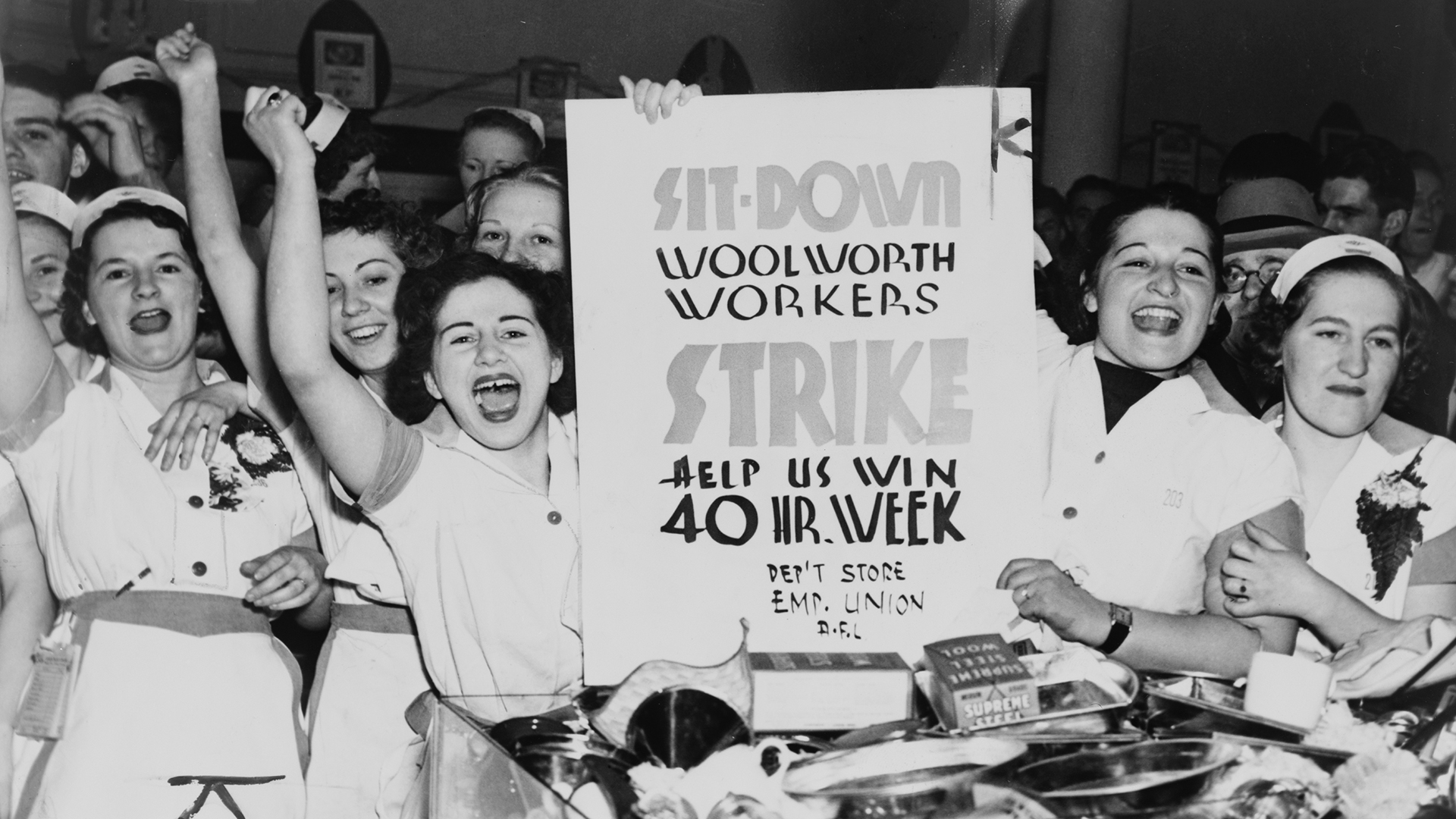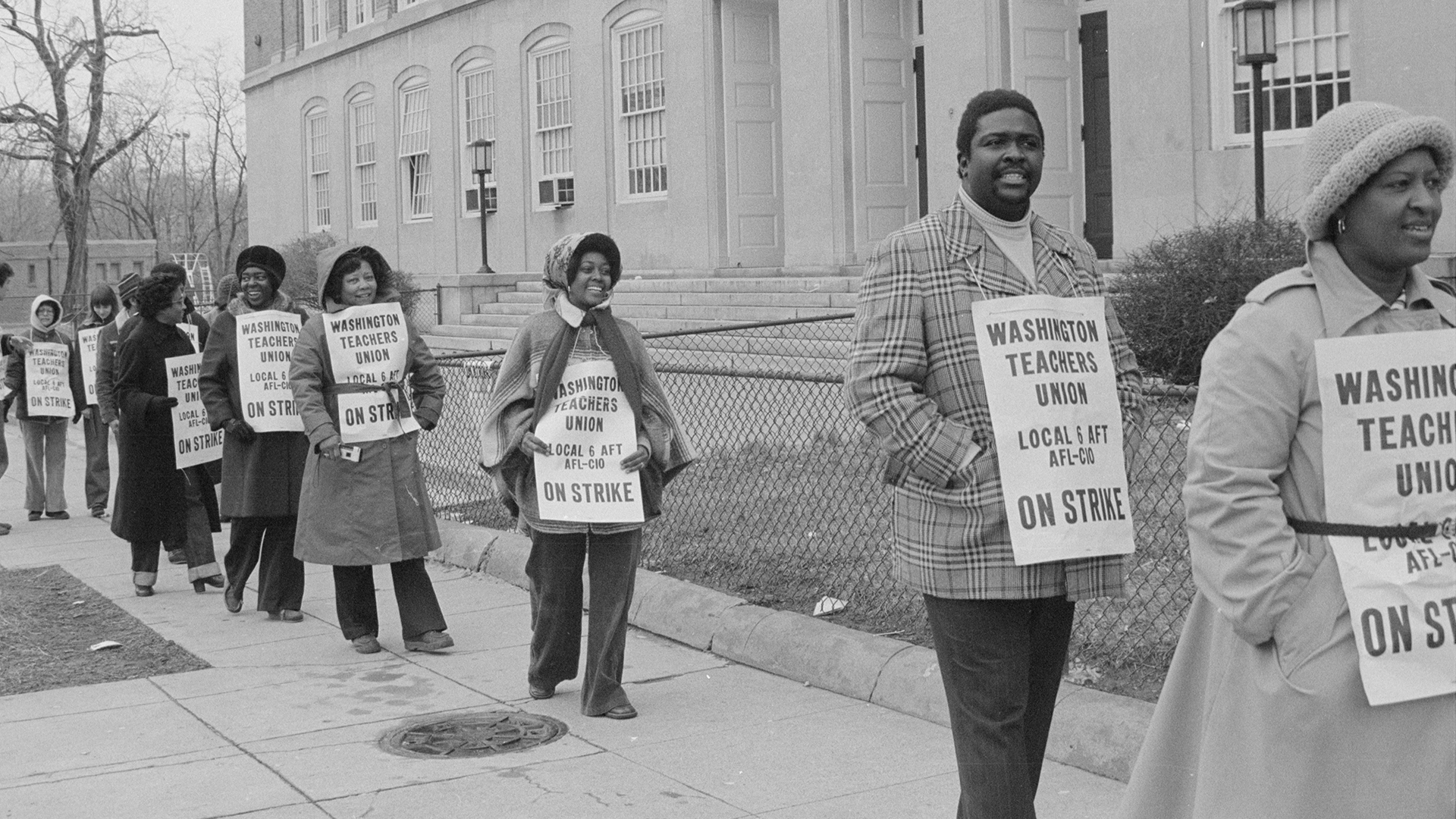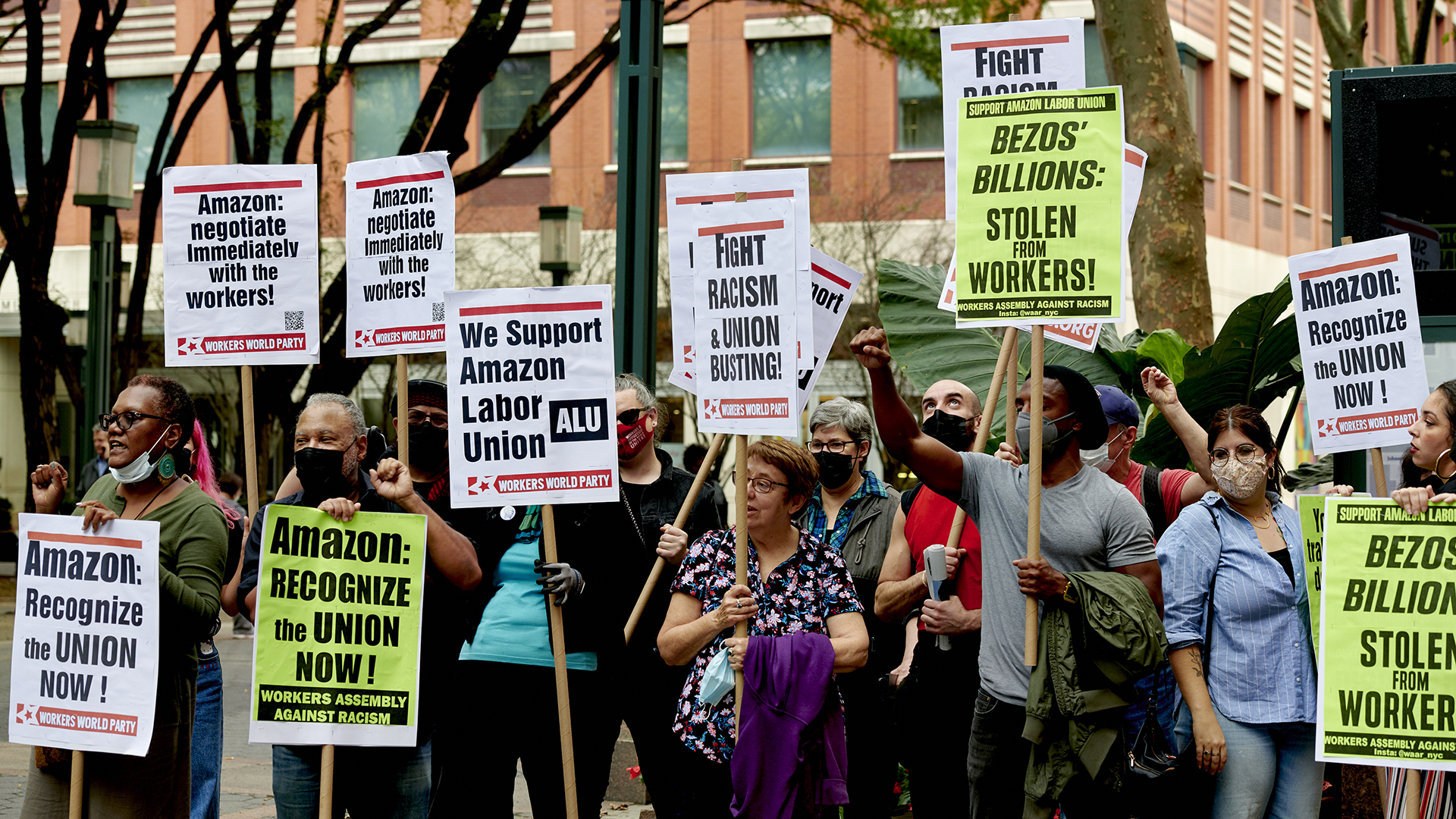What are labor unions?
Labor unions are organizations that represent workers in collective negotiations with employers.
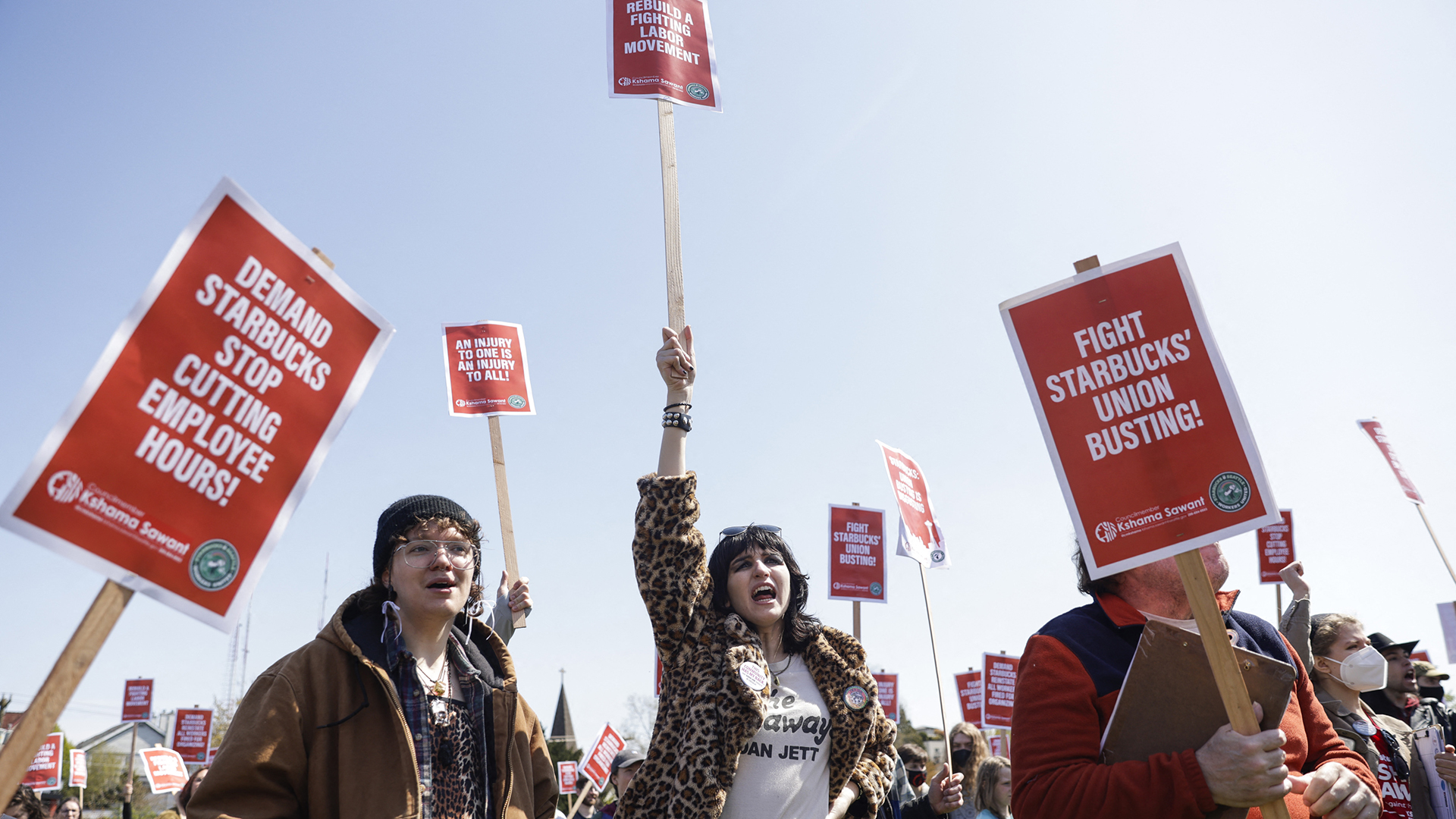
Labor unions are organizations that represent workers in negotiations with employers over rights, benefits and collective interests.
In the United States, organized labor rose alongside the industrial revolution in the late 1800s, accompanied by strikes that were often put down violently by the government and private company guards. The New Deal of the 1930s brought better protections for union members and their collective bargaining rights. The percentage of workers in unions peaked in the 1950s and declined precipitously in the 1980s, when globalization and deregulation heralded a shift in power away from organized labor.
As of 2021, only 10.3% of U.S. workers were union members, according to the U.S. Bureau of Labor Statistics. Some industries, however, are seeing an increased interest in unionization, and workers at large corporations, such as Amazon and Starbucks, are renewing their attempts to organize.
How does union organizing work?
Under the National Labor Relations Act, employees have the right to join or form unions and to engage in collective activities to address or improve their working conditions, or to refrain from these activities, according to the National Labor Relations Board.
The process of organizing typically begins with employees talking among themselves within a workplace, said Justin Molito, director of organizing for the Writers Guild of America, East. Once employees reach out to the union, staffers help by facilitating meetings and providing information on how to receive formal recognition.
"The first thing is to build the union and to build an organizing committee, which is made up of people who are committed to building the union," Molito told Live Science. "The next step is to have that [union] recognized formally and officially by the company."
Recognition can be extended voluntarily by the company agreeing to come to the negotiating table. If the company is resistant, the union can be recognized formally through the National Labor Relations Board via a secret ballot election process.
Get the world’s most fascinating discoveries delivered straight to your inbox.
What is the history of labor unions?
Historians once traced the history of organized labor to the advent of the industrial age — roughly the late 18th century to the mid-19th century — when factory workers toiling under grueling conditions first began striking and organizing for basic conditions, such as a maximum 10-hour workday. But in recent years, scholars have begun to follow these threads back further, into the fight against slavery and other forms of "unfree labor," said historian Nelson Lichtenstein, director of the Center for the Study of Work, Labor and Democracy at the University of California, Santa Barbara.
In the mid-18th century to the early 19th century, the driving ethos was around "liberty of contract," or the worker's right to enter into an independent contract with an employer. This notion was typically used against organized labor, on the logic that a union's collective bargaining would limit some workers' freedom to enter into contracts of their own accord.
"This idea of 'freedom of contract' in the late 19th century was very powerful," Lichtenstein said. Workers did unionize, he added, but there were few laws to protect their right to do so; as a result, governments and companies would often act violently to put down strikes.
This "age of industrial violence" was marked by unrest and bloody losses for organized labor. Some of the most famous events of this era include the following:
- Great Railroad Strike of 1877: Reacting to a 10% wage cut, railroad workers in West Virginia enacted a work stoppage that eventually spread across the nation. A violent putdown of strikers by federal troops in Pittsburgh only fanned the flames, according to the Heinz History Center, and the subsequent riot destroyed a large section of the city. However, the worker uprisings were more spontaneous than organized, and the strikers were quelled within weeks.
- Homestead Strike of 1892: Steelworkers went head-to-head with magnate Andrew Carnegie in 1892 after Carnegie Steel announced wage cuts at its plant in Homestead, Pennsylvania. Carnegie's men hired security from the famed Pinkerton Detective Agency, according to the Library of Congress, and the result was a pitched battle. With the Pinkertons and the striking workers trading fire, around a dozen people died. Eventually, the Pinkertons surrendered and were beaten by the crowd of strikers and their families. A force of 6,000 state militiamen ultimately put down the strike more than four months after it started.
- Pullman Strike of 1894: When the Pullman Palace Car Co. cut wages 25% without reducing rent in the company town of Pullman, Indiana, workers revolted, according to the Northern Illinois University Digital Library. Up to 250,000 railroad workers nationwide eventually went on strike in support of the Pullman workers, causing enormous disruptions to rail lines in the Midwest and in western U.S. states. Labor organizer Eugene V. Debs came to prominence during the strike, which was eventually broken by a federal injunction. As many as 30 striking workers were killed by the National Guard in Chicago. The strike ended after about three months without success for the workers.
- 1912 Lawrence Textile Strike: The textile mills of Lawrence, Massachusetts, were staffed by a largely immigrant, mostly female workforce, according to the Digital Public Library of America. When the workweek was cut by two hours in 1912, reducing the workers' pay, the workers went on strike, organizing under the Industrial Workers of the World. After months of unrest, violence and congressional investigations into the horrid working conditions at the mills, the textile owners settled, agreeing to most of the workers' demands.
- Paint Creek-Cabin Creek Strike of 1912: Sparked by a coal miner's dispute over wages, this West Virginia strike was put down by the Baldwin-Felts Detective Agency, according to PBS' American Experience. More than 50 people were killed before the strike ended in 1913.
- Ludlow Massacre of 1914: Coal miners and coke-oven workers in Colorado went on strike in September 1913, demanding better wages and working conditions from company owner John D. Rockefeller Jr. On April 20, 1914, an anti-strike militia opened fire on a tent camp of striking workers and their families, setting the camp ablaze and killing an estimated 21 people, including two women and 11 children, according to American Experience. The deaths became a flash point in labor relations, prompting a congressional investigation and contributing to the establishment of child labor laws, according to the Denver Public Library.
By the 1930s, public and political opinion were increasingly supportive of workers' rights, Lichtenstein said. The National Labor Relations Act (also called the Wagner Act) of 1935, signed by President Franklin D. Roosevelt, gave workers the right to unionize and established the National Labor Relations Board to enforce employee rights. The Wagner Act, for the first time, provided a mechanism for resolving labor disputes in a peaceful way, Lichtenstein said.
Union membership grew throughout the 1940s and 1950s, Lichtenstein said. And though unions today are largely associated with the Democratic Party and liberal politics, liberals were not necessarily in favor of unions in the mid-20th century. Many unions had relatively conservative leadership that could be resistant to recruiting Black members, Lichtenstein said, and unions and liberals sometimes had opposing views on other issues, including the Vietnam War. (At the same time, Lichtenstein noted, unions were often a force of racial inclusion, bringing Black and immigrant workers into the political process.)
Unions' power began to erode in the 1970s and 1980s, because of globalization and increasing pushback from employers. Perhaps the key moment in this pendulum swing was the strike of the Professional Air Traffic Controllers Organization (PATCO) in 1981. PATCO went on strike after contract negotiations with the Federal Aviation Administration stalled over pay and the length of the workweek, according to the University of Texas at Arlington Libraries. President Ronald Reagan ordered the air traffic controllers back to work under the Taft-Hartley Act, a 1947 revision to the Wagner Act that limited union power and banned strikes that affect national security. More than 11,000 strikers who refused to return to work were fired, and PATCO was decertified as a union.
This sent a signal to businesses that unions could be not just defeated at the negotiating table, but demolished, Lichtenstein said.
"Unions had lost strikes over the previous 50 years, but they usually weren't destroyed," he said.
Unions today
The percentage of workers represented by a union in the United States is now about half of what it was in 1983, according to the Bureau of Labor Statistics. In 1983, 20.1% of U.S. workers were unionized. As of 2021, that number stood at 10.3%. About 33% of public-sector workers are represented by unions, compared with 6.1% of private-sector workers. South Carolina, North Carolina and Utah have the lowest rate of union membership, while Hawaii and New York have the highest.
Between 2020 and 2021, the percentage of U.S. workers represented by a union dropped 0.5%, to 2019 levels. However, there has been a resurgence of interest in unionization in the past several years. The media and broadcast industry saw at least 37 successful unionization drives in 2020, according to Poynter, and at least 29 new drives in the first half of 2021. This media unionization push is part of a larger trend of unionization in white-collar creative industries, Lichtenstein said.
Workers at large companies that have avoided unionization in the past are now making new attempts. Amazon workers at a warehouse in Staten Island, New York, voted to unionize in March 2022, an effort that the online retail giant has challenged in court, according to NBC News. In April 2022, the National Labor Relations Board sued coffee chain Starbucks for retaliating against three employees who were involved in union organizing. In recent years, dozens of Starbucks stores across the country have voted on unionization, and the vast majority have voted in favor, NPR reported in April 2022; hundreds more are seeking union elections.
"The issues we saw early on in the media industry are being felt across all different sectors of the economy," Molito said. "I would describe those as the inability to have a basic standard of living through both a combination of benefits, pay, fair treatment and respect."
Additional resources
The American Federation of Labor and Congress of Industrial Organizations, the largest federation of unions in the U.S., offers guidelines for forming a union. For a deeper dive into the historical ups and downs of unionizing in America, read "State of the Union: A Century of American Labor – Revised and Expanded Edition" (Princeton University Press, 2013), by Nelson Lichtenstein. Learn about the far-reaching implications of union activity for the U.S. in "A History of America in 10 Strikes" (The New Press, Reprint Edition, 2020), by Erik Loomis.
Bibliography
American Experience. (n.d.). Labor wars in the U.S. PBS. Retrieved April 28, 2022, from https://www.pbs.org/wgbh/americanexperience/features/theminewars-labor-wars-us
American Experience. (n.d.). The Ludlow massacre. PBS. Retrieved April 28, 2022, from https://www.pbs.org/wgbh/americanexperience/features/rockefellers-ludlow
Barera, M. (2021, September 2). The 1981 PATCO strike. University of Texas at Austin Libraries. https://libraries.uta.edu/news-events/blog/1981-patco-strike
Fu, Angela. (2021, July 16). Not just a wave, but a movement: Journalists unionize at record numbers. Poynter. https://www.poynter.org/business-work/2021/not-just-a-wave-but-a-movement-journalists-unionize-at-record-numbers/
Hernandez, J. (2022, April 24). NLRB sues Starbucks for retaliating against 3 workers involved in unionizing. NPR. https://www.npr.org/2022/04/24/1094569620/nlrb-sues-starbucks-for-retaliating-against-3-workers-involved-in-unionizing
Kellen. (2013, September 15). The Ludlow massacre. Denver Public Library: Genealogy, African American & Western History Resources. https://history.denverlibrary.org/ludlow-massacre
Lawrence History Center, Lawrence, Massachusetts, and University of Massachusetts Lowell History Department and students. (n.d.). Bread and Roses Strike of 1912: Two Months in Lawrence, Massachusetts, that Changed Labor History. Part of the Digital Commonwealth. Retrieved April 28, 2022, from https://dp.la/exhibitions/breadandroses
Matsakis, L. (2022, April 25). Can Amazon stop a union? NBC News. https://www.nbcnews.com/business/can-amazon-stop-union-rcna24050
National Labor Relations Board. (n.d.). Frequently asked questions - NLRB. Retrieved April 28, 2022, from https://www.nlrb.gov/resources/faq/nlrb
National Labor Relations Board. (n.d.). 1935 passage of the Wagner Act. Retrieved April 28, 2022, from https://www.nlrb.gov/about-nlrb/who-we-are/our-history/1935-passage-of-the-wagner-act
Schneirov, R. (n.d.). The Pullman strike. Retrieved April 28, 2022, from https://digital.lib.niu.edu/illinois/gildedage/pullman
U.S. Bureau of Labor Statistics. (2022, January 20). Union members - 2021. U.S. Department of Labor. https://www.bls.gov/news.release/pdf/union2.pdf
Originally published on Live Science

Stephanie Pappas is a contributing writer for Live Science, covering topics ranging from geoscience to archaeology to the human brain and behavior. She was previously a senior writer for Live Science but is now a freelancer based in Denver, Colorado, and regularly contributes to Scientific American and The Monitor, the monthly magazine of the American Psychological Association. Stephanie received a bachelor's degree in psychology from the University of South Carolina and a graduate certificate in science communication from the University of California, Santa Cruz.


